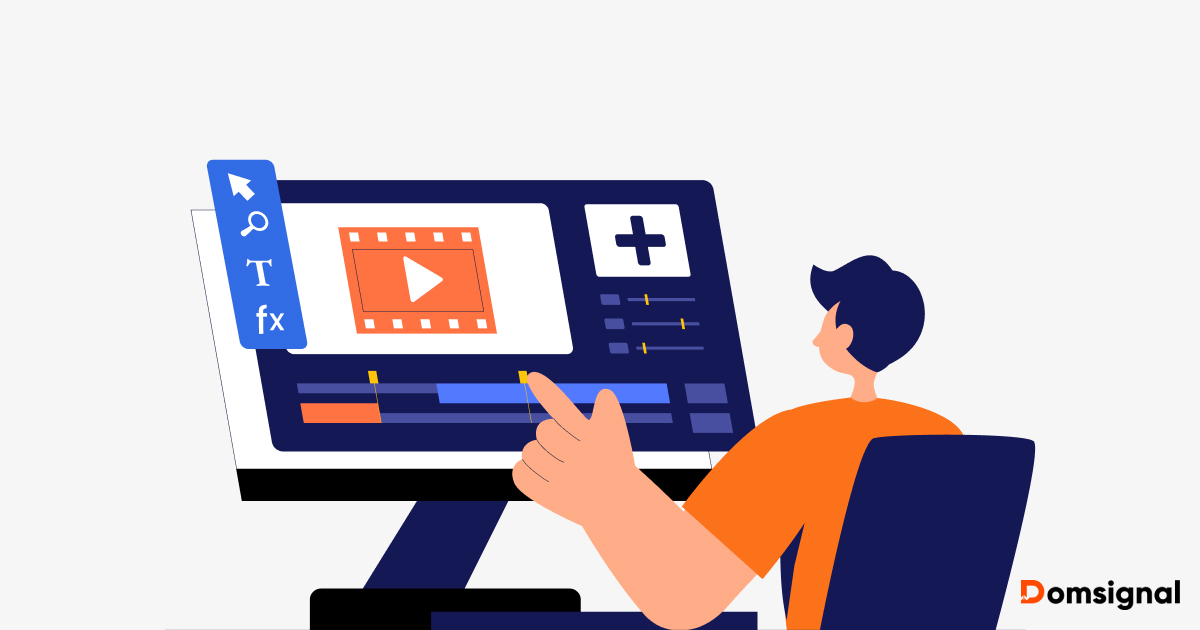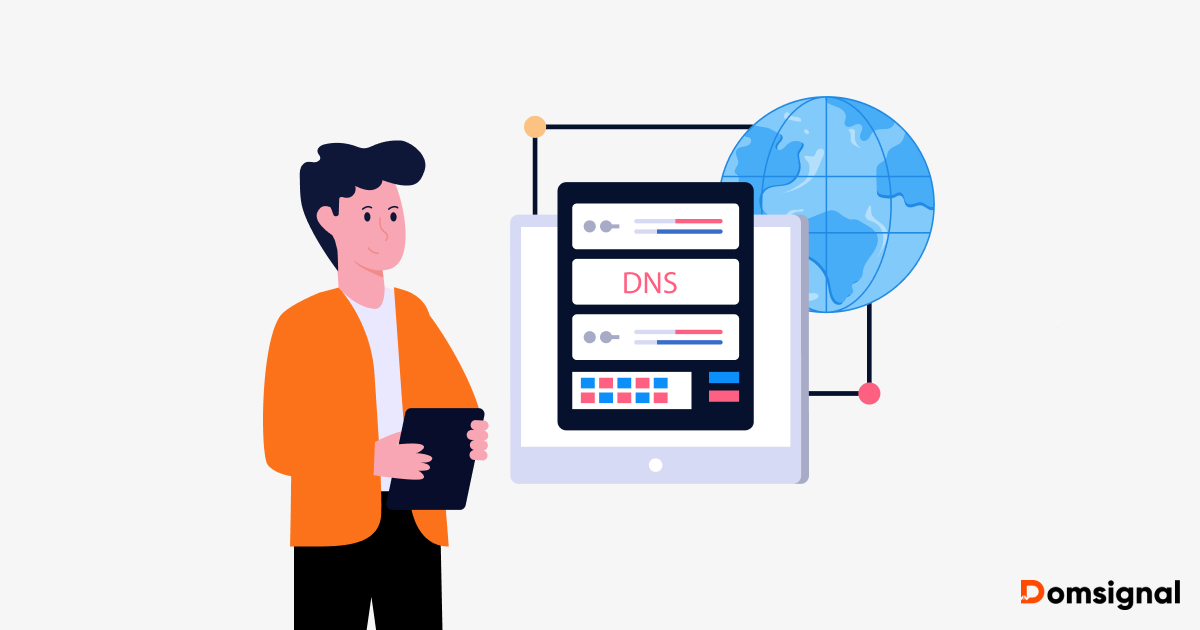Have you ever found out if your audience engages with your website? Are your website visitors converting into potential customers? You might have found these answers with A/B testing. If not, here’s what it means.
You might lose opportunities when you change your website while learning about their impact. A/B testing measures different variations’ effects on websites, so businesses can improve their digital presence by understanding user behavior. When you test elements like headlines, layouts, or buttons, you get a chance to boost engagement and conversions by enhancing user satisfaction.
Good A/B testing tools streamline this process by eliminating guesswork and making it easier to analyze what resonates with visitors. These tools provide structured experiments, reliable data, and actionable results for businesses looking to improve their website’s potential.
Understanding A/B Testing
A/B testing involves a comparison of two versions of an app or a webpage and finding the one that performs better by displaying it to different users. This type of testing enables businesses to make decisions based on measurable outcomes like click-through rates, form submissions, or purchases. With this testing, businesses can fine-tune their strategies by identifying what attracts and retains customers.
It further helps to improve website performance, reduce bounce rates, and increase conversions. Data-driven adjustments can lead to higher revenue and better user experiences. With the right approach, businesses can continuously refine their online presence, making each change more effective than the last.
Powerful A/B Testing Tools for 2025
1. Optimizely
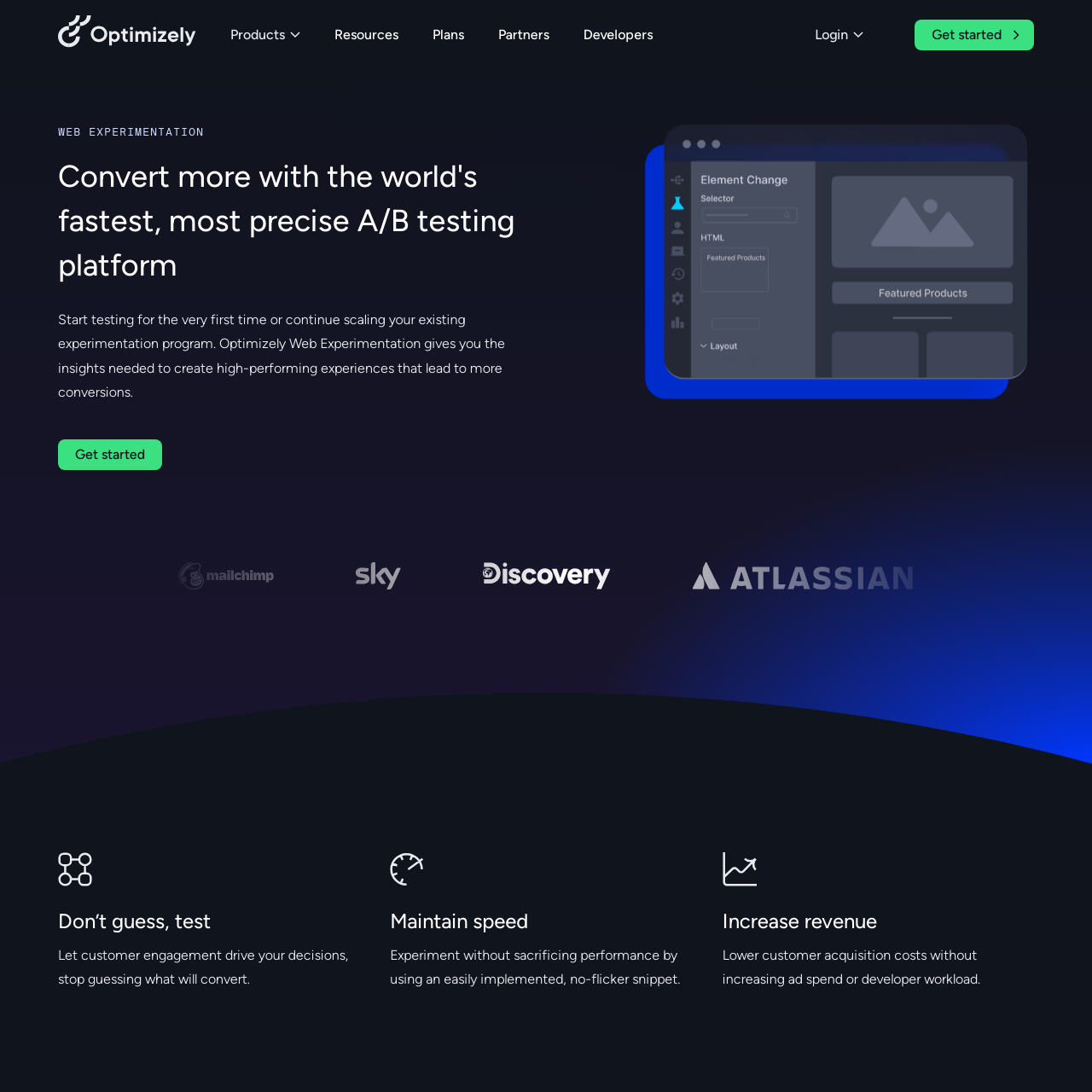
Optimizely is a leading A/B testing platform that helps businesses experiment with website changes, personalization, and feature rollout for better user engagement.
Key Features
- Collaborate with Team: Collaborate with everyone to enhance experimentation by using video collaboration software, shared workspaces, visual calendars, and customizable intake forms.
- Create Easy Experiment Reports: Offers low code, extension templates, a visual editor, and AI content suggestions for designing beautiful experiments, catering to technical experts and general users.
- Faster Execution: The tool’s Stats Accelerator offers fast, statistically sound results. It optimizes traffic distribution using AI and segmentation based on behavioral and demographic data. It supports CDN A/B testing and audience targeting.
- Precise Analysis: The Stats Engine enhances experiment learnings, accuracy, and outcomes. It provides configurable dashboards for quick decision-making and integrates seamlessly into analytics tools for tech stack connection and data consistency.
Business Pain Points
- Businesses find it difficult to run large-scale experiments across multiple platforms.
- There is a need for deep integrations with analytics and customer data platforms.
How Optimizely’s A/B Testing Works?
- Optimizely’s robust experimentation supports websites, mobile apps, and connected devices.
- Its seamless integrations with popular analytics and data tools refines testing and personalization.
Who uses it?
Discovery, Atlassian, and Mailchimp rely on Optimizely for large-scale experimentation.
Limitations
- Premium pricing may not be suitable for smaller businesses
- Requires technical expertise for advanced server-side experiments
Pricing Structure
You can request a custom quote based on your business needs.
2. VWO
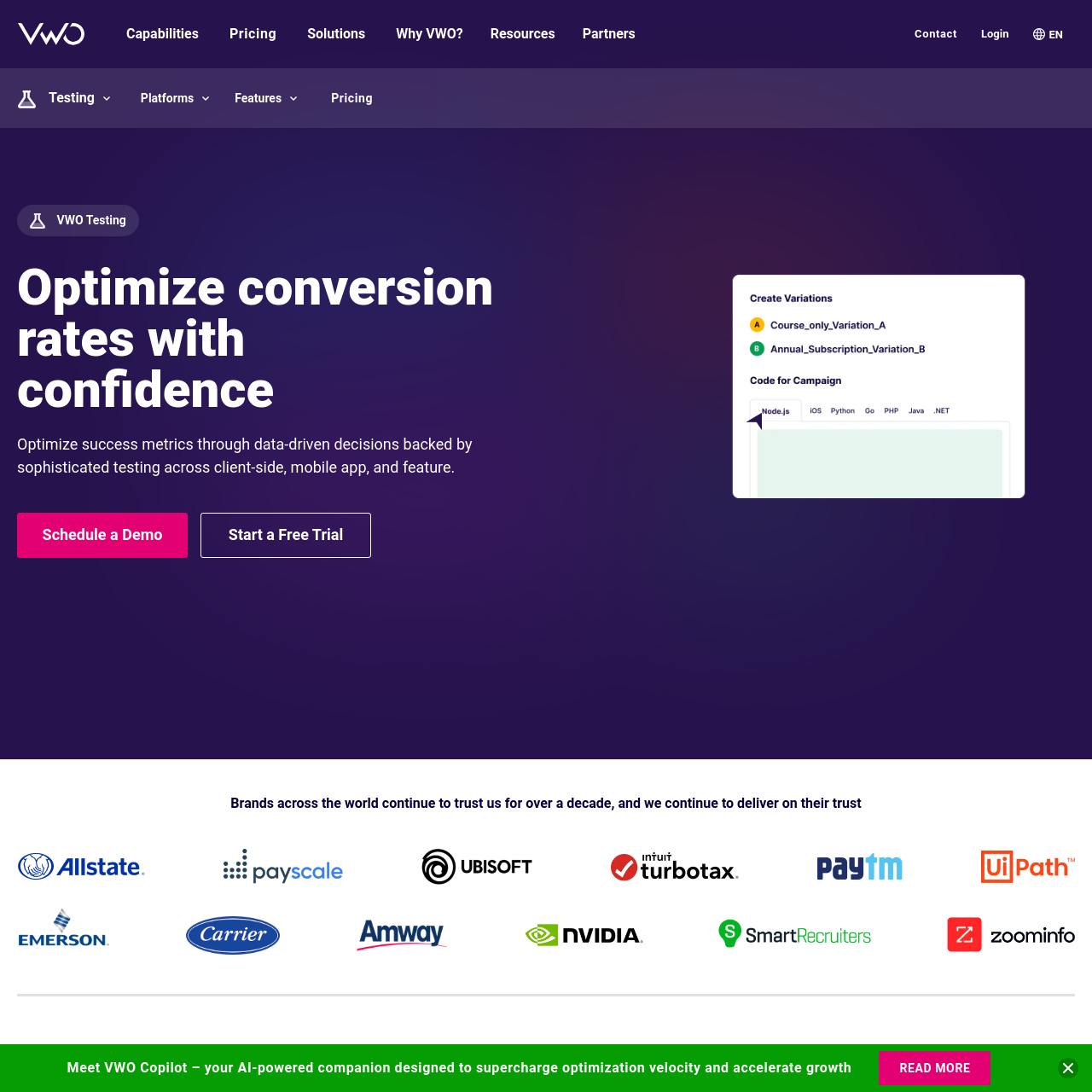
A conversion optimization tool, VWO offers A/B testing, heatmaps, and behavioral analytics to refine website experiences and increase conversions.
Key Features
- Test Your Complete Tech Stack: Centralize testing for the product, marketing, and development teams. VWO allows you to test anything from content to UI, search results, and algorithms in one place.
- Select Your Test Audience: Extensive audience selection options based on your user data allow you to run tests precisely as you want.
- Optimize Experiences by Tracking Metrics: VWO’s custom goals enable you to run tests to optimize KPIs that are important to your business.
- Make Data-Driven Decisions: Accurate Bayesian statistics-based reports to assist you and your stakeholders in making precise data-driven business decisions.
- Rollout Variations Instantly: Do not let your winning versions stay idle. To boost conversions, roll them out right away.
Business Pain Points
- Setting up tests without technical expertise.
- Gaining no actionable insights from A/B test results.
How VWO’s A/B Testing Works?
- VWO offers a user-friendly, no-code interface, allowing marketing teams to set up experiments easily.
- Its statistical engine and intuitive reports help in data-driven decision-making.
Who uses it?
Amway, Ubisoft, and Paytm use VWO to optimize their digital experiences.
Limitation
- Limited features in lower-tier plans
- Advanced reporting requires manual setup
Pricing Structure
VWO offers a free Starter plan, Growth plan at $275, Pro plan at $633 and Enterprise plan at $1,107. All these plans offer a free trial for 30 days.
3. AB Tasty
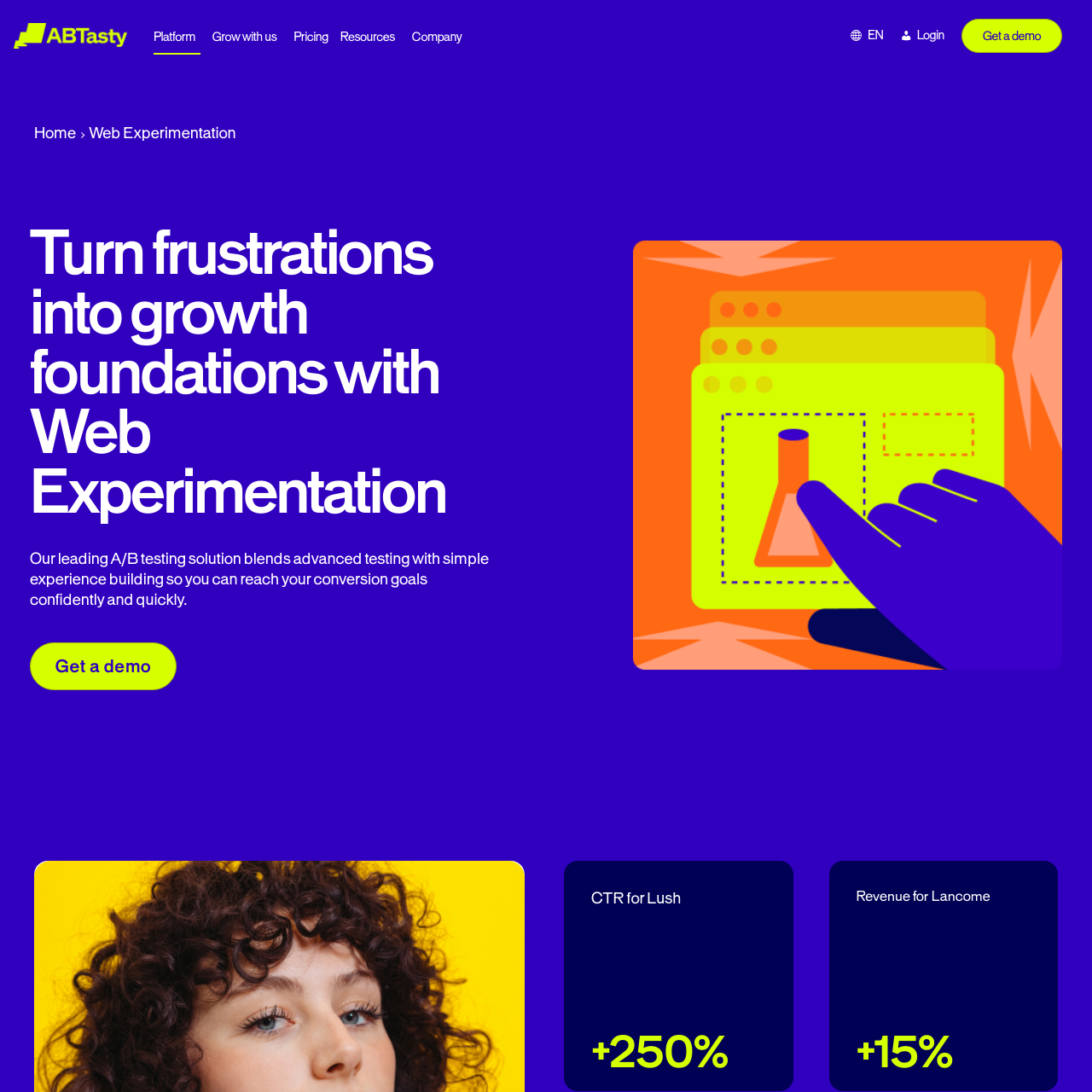
AB Tasty offers user-friendly experimentation with A/B testing, personalization, and AI-powered optimization to enhance digital performance.
Key Features
- Make Informed Decisions: Blend advanced testing with simple experience building to achieve conversion goals confidently and quickly.
- Multi-channel A/B Tests: Conduct extensive experiments across all channels and devices, conduct multi-channel A/B tests without affecting performance, and test mobile app ideas before full release using an agnostic API or SDK.
- Personalize Experiences: Personalize experiences to each individual, combining specificity and scale, and launch them quickly using advanced segmentation based on emotional needs or brand engagement.
- Recommendations: Customize product selection and cross-sell opportunities and bundles for individual customers. Add recommendations to the homepage and PDPs to enhance cart value and product discovery.
- AI-powered Search Engine: AI-powered search engine enhances catalog showcase, personalizes results, boosts bounce rates, and engages shoppers, reducing frustrations and providing tailored product results.
- Release New Features: The strategy involves releasing new features quickly and confidently, gradually testing them in production, and minimizing risk through automatic KPI-triggered rollbacks.
- AI-Powered Experiences: The tool focuses on enhancing productivity and user engagement through AI-enhanced experiences, including the market-first EmotionsAI.
Business Pain Points
- Setting up personalized experiments and featuring rollouts is complex.
- Non-technical users need to invest more time in the experimentation process.
How AB Tasty’s A/B Testing Works?
- AB Tasty easy-to-use interface contains pre-configured templates for various tests.
- Teams can launch tests and feature rollouts without completely relying on developers.
Who uses it?
Samsonite, Ulta Beauty, and GANNI trust AB Tasty for personalization and testing.
Limitation:
- Higher cost compared to some alternatives
- Steeper learning curve for advanced features
Pricing Structure
AB Tasty offers custom pricing based on your business requirements.
4. Adobe Target
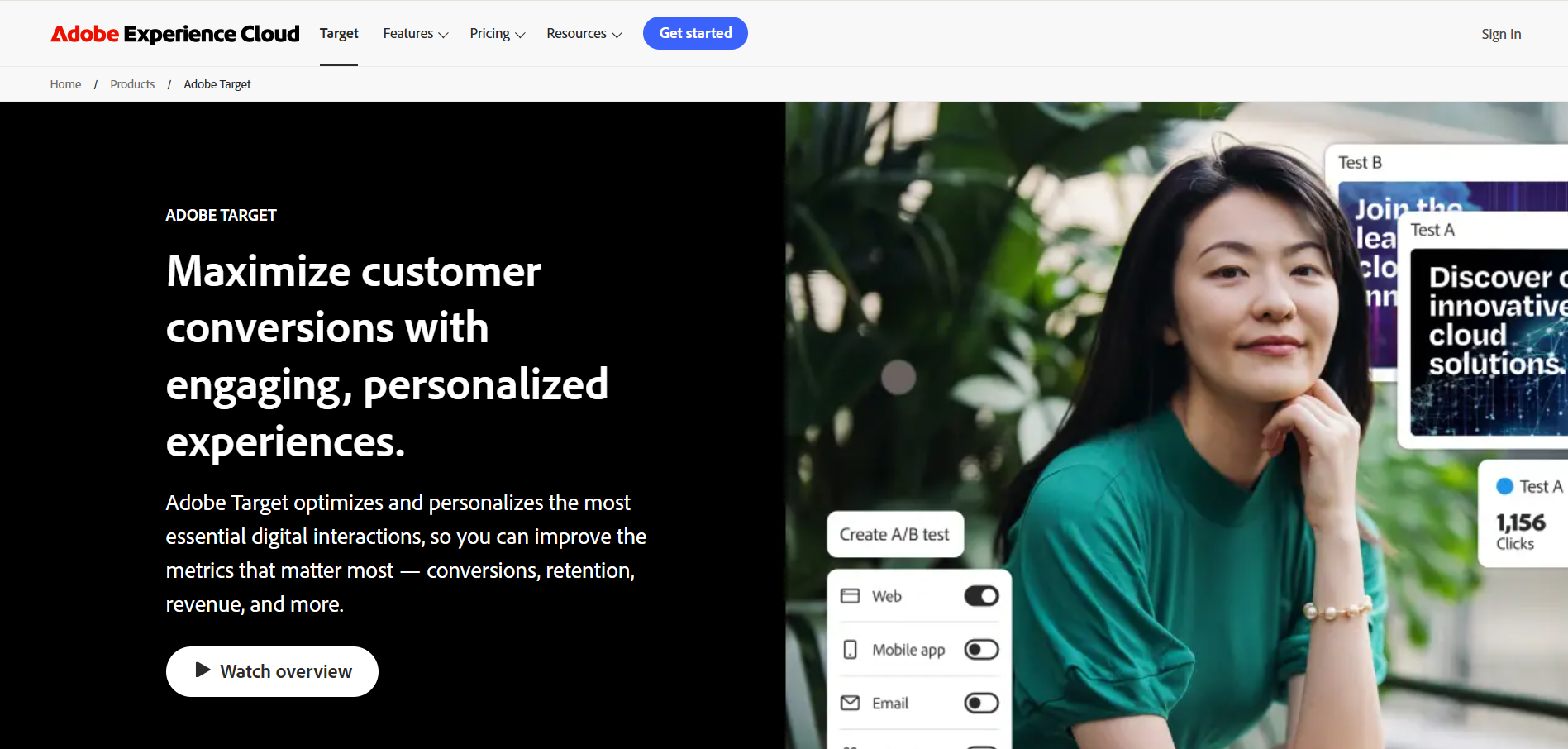
Adobe Target is a powerful tool by Adobe Experience Cloud that enables AI-driven testing, personalization, and automated decision-making for tailored user experiences.
Key Features
- Personalized Interactions: Utilizes a real-time decision-making engine to deliver relevant content and offers based on visitor interactions. Segments audiences by using rule-based criteria. It also ranks order offers and navigation options for conversion.
- Fine-Tuned Experiences and Optimization: Utilizes manual and AI-powered experimentation to optimize content and A/B test experiences, allocate traffic to best-performing digital experiences, and improve algorithm performance and AI-powered personalization activities.
- Quick Scaling: Allows quick scaling of personalization and optimization programs.
- Visual Guidance: Offers guided visuals and workflows for stakeholder approval of journey variations.
- Intuitive Interface: Easy to use user interface helps to perform faster-personalized activities.
- AI Assistant – Product Knowledge: It helps to personalize and use case ideas.
- AI Assistant – Content Accelerator: It helps to create campaign copy and offers imagery suggestions.
Business Pain Points
- Enterprises require highly personalized, AI-driven experimentation.
- Need for deep integration with other marketing tools.
How Adobe Target’s A/B Testing Works?
- Offers AI-powered automation for personalized experiences at scale.
- Seamlessly integrates with Adobe Experience Cloud for a unified marketing approach.
Who uses it?
Top companies like AT&T, Nvidia and City National Bank rely on Adobe Target.
Limitation
- Requires technical expertise to unlock full capabilities
- High pricing may not be suitable for smaller businesses
Pricing Structure
Adobe Target offers Enterprise-level custom pricing.
5. Kameleoon
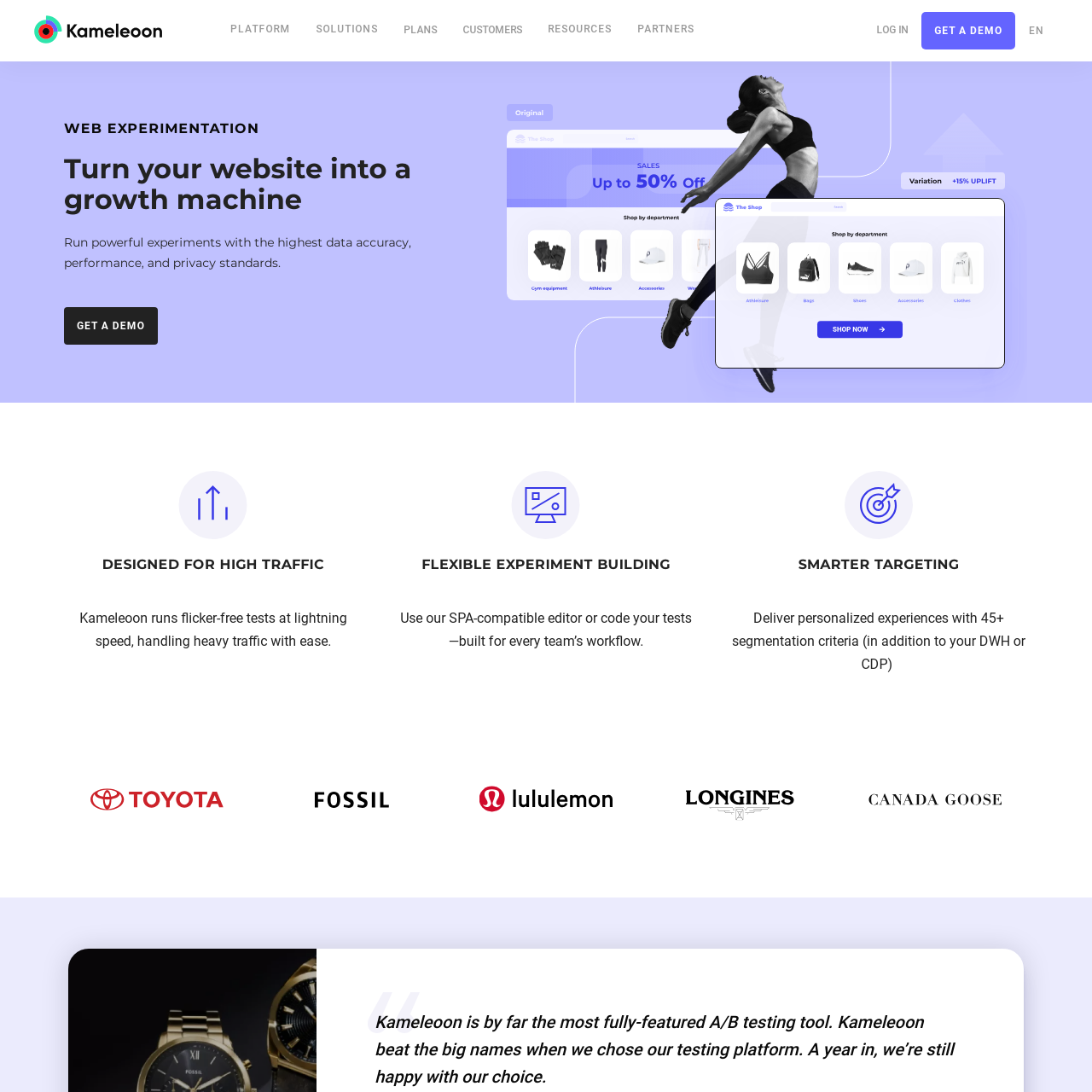
An advanced optimization tool, Kameleoon helps you grow on any web channel with A/B testing, personalization, and predictive targeting leading to improved customer journeys across digital channels.
Key Features
- Unlimited A/B and Multivariate Testing: With infinite A/B and multivariate test permutations, the testing tool allows marketers to test and optimize every desktop and mobile experience easily.
- Link Testing to Business Goals: Use one of Kameleoon’s pre-existing goals or develop your own to monitor how an A/B test affects conversion rate, retention, or visitor engagement.
- Developer-friendly Code Editor: The code editor allows developers to construct more complicated experiments directly with JavaScript and CSS code—no WYSIWYG required.
- Easily Change the Design and Copy: The intelligent graphic editor detects and allows anyone to change or hide text, colors, images, call-to-action buttons, banners, and entire page sections. There is no need for prior coding experience.
- Extensive Library of Widgets: Use or modify one of the existing widgets to effortlessly create a better user experience across all devices. Users can create new templates without the need for a developer.
- Audience Segmentation: Creates segments in real-time depending on visitor origin, behavior, or the pages. The platform has over 45 native criteria for segmenting your audience.
- Simulate, Validate, and Share Tests: See exactly how your test hypotheses will function for your chosen audience. Easily communicate the entire experience to key stakeholders for buy-in and approval.
- Allocate Traffic Dynamically: Manually assign traffic to a variant, or let Kameleon’s multi-armed bandit push traffic to win variants before the test ends.
- HIPAA, GDPR, and CCPA Compliant: The tool’s customizable user consent management functionality allows companies to tailor their consent management policy to any form of A/B test.
Business Pain Points
- Businesses need advanced targeting and personalization without complex setups.
- Manual segmentation is inefficient for large datasets.
How Kameleoon’s A/B Testing Works?
- Provides AI-driven segmentation and targeting capabilities.
- Features an intuitive interface to create and manage experiments with ease.
Who uses it?
Lexus, Swarovski, and Providence leverage Kameleoon for personalization.
Limitation
- Requires technical expertise for advanced testing
- Premium pricing may limit accessibility for smaller teams
Pricing Structure
Kameleoon offers custom pricing tailored to business needs.
6. Apptimize Inc.
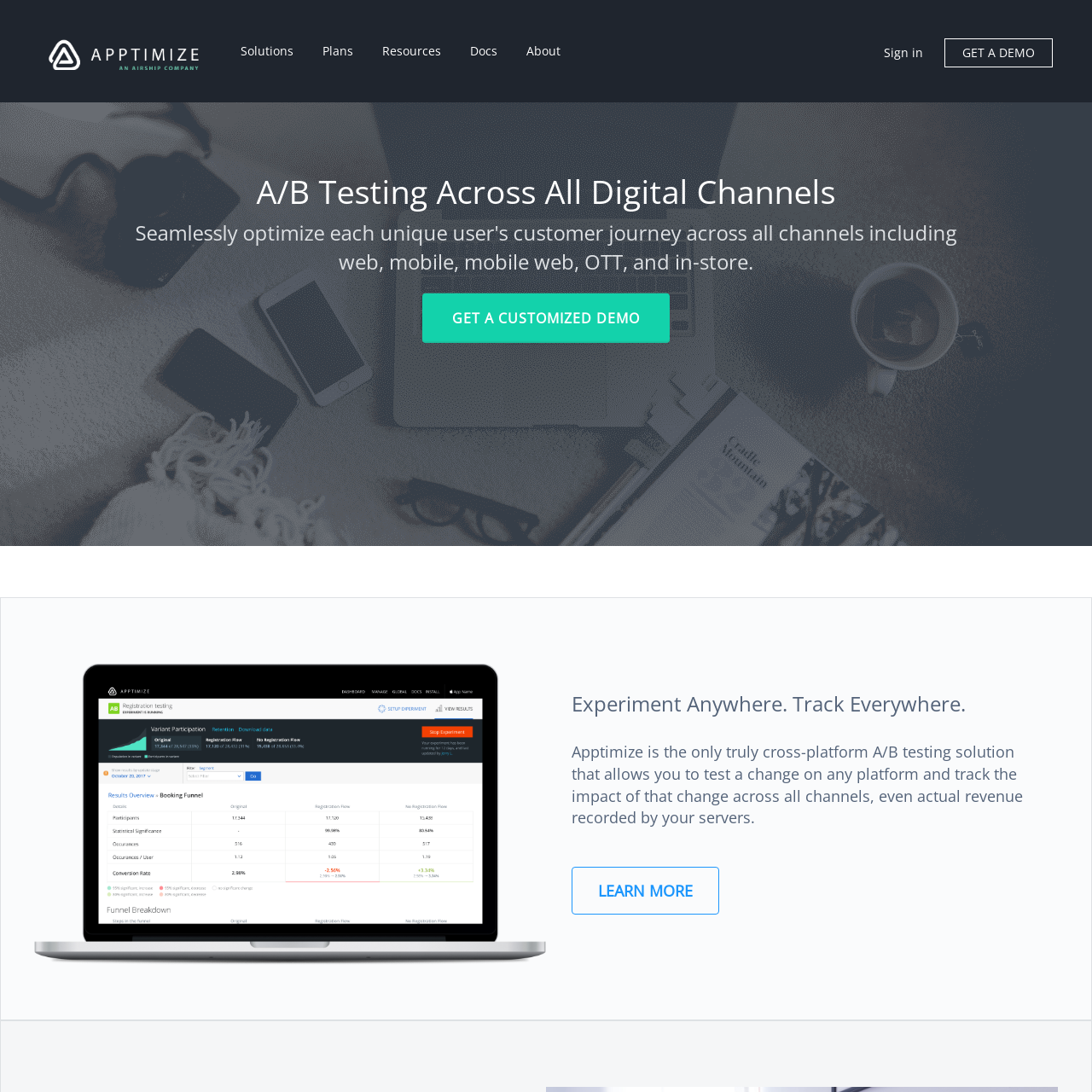
Apptimize is a mobile-first experimentation tool designed to test app features, optimize user experiences, and drive engagement across iOS and Android.
Key Features
- Cross-Platform Optimization: Optimizes customer digital touchpoints across multiple platforms, ensuring consistent user experience and tracking their impact across all platforms in a multi-channel world.
- Optimization for Each Unique User: Tracks user movement across channels, ensuring consistent experiences across platforms and enabling the impact of A/B tests on revenue earned.
- Grow Customers 2X Faster: Enhances product team efficiency, leading to increased growth for customers who conduct over eight experiments annually, over two times faster than the industry average.
- Seamless Integration with Technology: Offers a comprehensive cross-platform testing and release management solution, seamlessly integrating with technology stacks and automatically incorporating events from major push and analytics providers.
Business Pain Points
- Mobile-first businesses struggle with A/B testing on apps.
- Difficulty in ensuring feature rollouts don’t disrupt user experience.
How Apptimize’s A/B Testing Works?
- Specializes in mobile A/B testing and cross-platform experiments.
- Offers feature flagging to enable controlled rollouts and minimize risk.
Who uses it?
Hotel Tonight, and The Wall Street Journal, use Apptimize to test mobile experiences.
Limitation
- Limited capabilities for web-based testing
- Requires coding knowledge for complex tests
Pricing Structure
Apptimize offers a Standard free plan, and you can get a custom quote for other plans based on your requirements.
7. Omniconvert S.R.L.
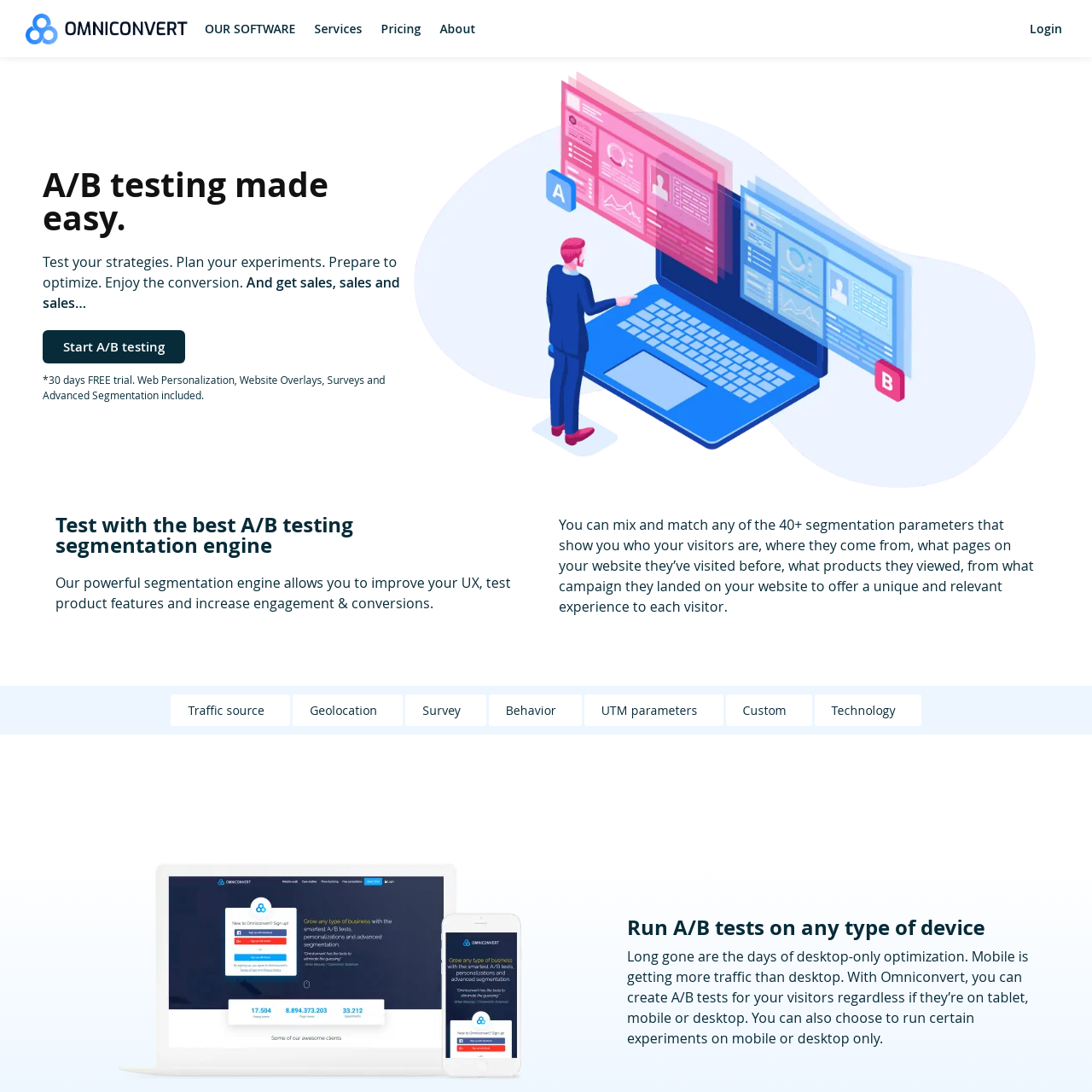
A CRO-focused tool, Omniconvert S.R.L. offers A/B testing, surveys, and advanced segmentation to help businesses improve website performance and customer retention.
Key Features
- Improves Customer Lifetime Value: Utilize customer data to create personalized audiences for Meta and Google, enhancing acquisition by targeting customers who spend more and return more frequently.
- Grow Efficiently with Insights: Utilize customer surveys to identify strengths and areas for improvement, make informed business decisions based on customer feedback, and enhance all processes.
- Convert Website Traffic into Leads: Utilize A/B Testing, Website Personalization, Overlays, and Surveys to enhance UX/UI and boost conversion rates by creating a high-performing website with a strong CRO.
- Make informed decisions: Avoid shallow metrics and focus on revenue-impacting ones like ROAS, CAC, AOV, Customer Lifetime Value, and Retention Rate, taking action on low-performing metrics and investing in tasks.
Business Pain Points
- Businesses need a complete CRO (Conversion Rate Optimization) platform beyond A/B testing.
- Difficulty in gathering real-time customer feedback.
How Omniconvert’s A/B Testing Works?
- Omniconvert combines A/B testing with heatmaps, surveys, and session recordings for comprehensive CRO.
- Enables businesses to make real-time, data-driven optimizations.
Who uses it?
Samsung, Decathlon, and Orange optimize their websites using Omniconvert.
Limitation
- Limited reporting compared to other tools
- The interface may require improvement for better usability
Pricing Structure
Omniconvert offers a starter plan at $273/mo paid annually for 50K users with a trial period of 30 days. The pricing increases depending on the number of users estimated to test each month.
8. Convert.com
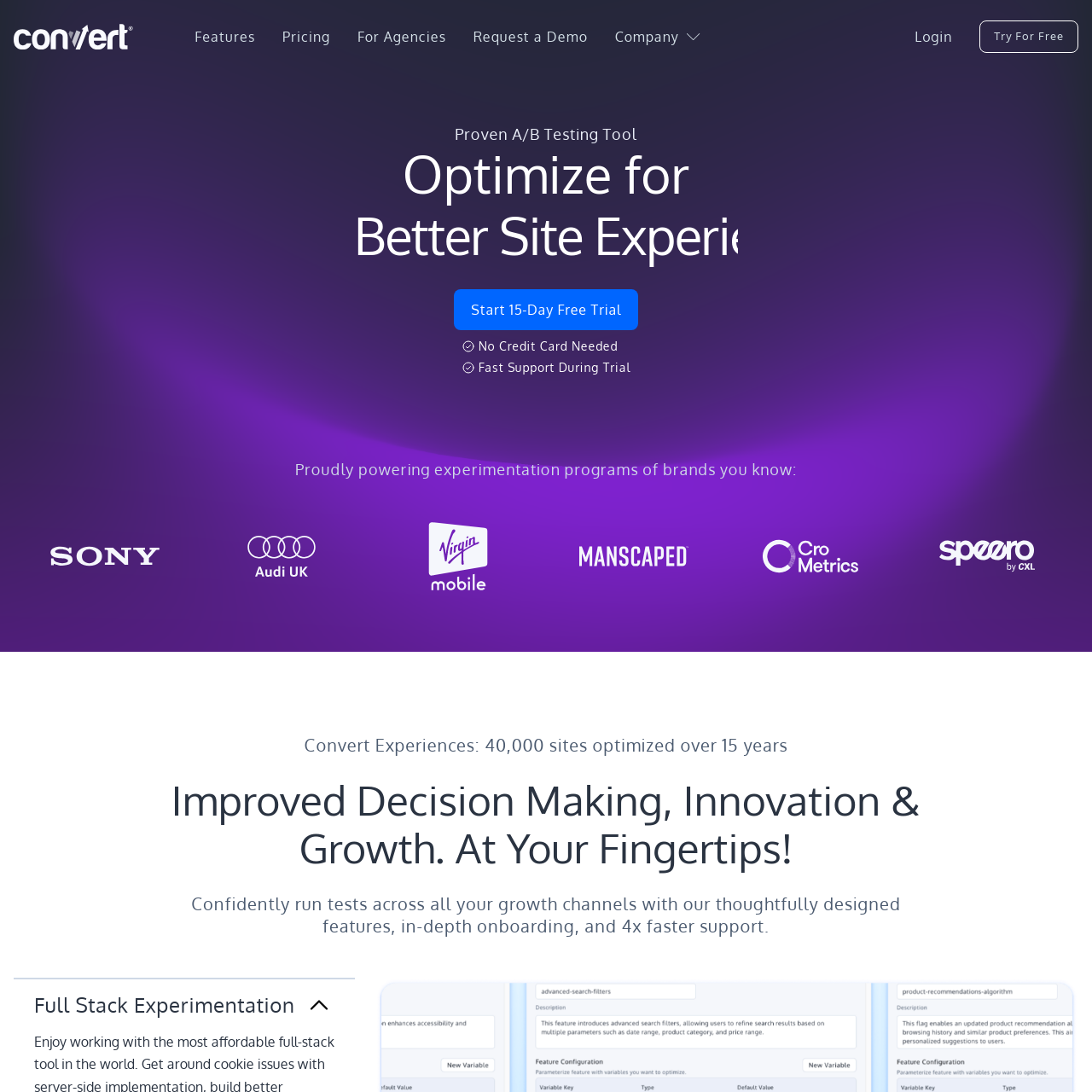
A privacy-friendly A/B testing tool, Convert is known for its advanced targeting, seamless integrations, and data-driven approach to conversion rate optimization.
Key Features
- Advanced Audience Targeting: Enables businesses to test specific audience segments, ensuring accurate results by targeting users based on geolocation, device type, browser, referral source, cookies, or custom variables.
- Privacy-Focused Testing: The platform is GDPR and CCPA-compliant, offering built-in privacy controls and third-party cookies, making it an ideal choice for businesses prioritizing user privacy.
- A/B, Split URL, and Multivariate Testing: Convert.com offers A/B, Split URL, and Multivariate Testing for comparing webpage versions, identifying optimal combinations, and comparing different versions on separate URLs.
- Faster Implementation with Minimal Coding: Offers a user-friendly visual editor for quick test setup, allowing developers to integrate JavaScript-based tests for complex experiments.
- Complete Stack Experiments: Experimentation enhances growth channels and strategies, overcoming cookie issues and data potential through server-side testing. Improve product release speed through feature flagging and rollouts.
Business Pain Points
- Privacy concerns and compliance issues in A/B testing.
- Need for advanced personalization without affecting page performance.
How Convert’s A/B Testing Works?
- Convert offers privacy-first experimentation with GDPR and CCPA compliance.
- Uses anti-flicker technology to ensure smooth user experiences.
Who uses it?
Sony, UNICEF, and Kiva use Convert.com for secure A/B testing.
Limitation
- Not as widely recognized as larger competitors
- Limited AI-driven personalization
Pricing Structure
For Enterprise plan, businesses need to contact sales to get the quote. Convert’s Pro plan starts at $499/month and the Growth plan starts at $299/month with a 15-day free trial for both plans.
9. Crazy Egg
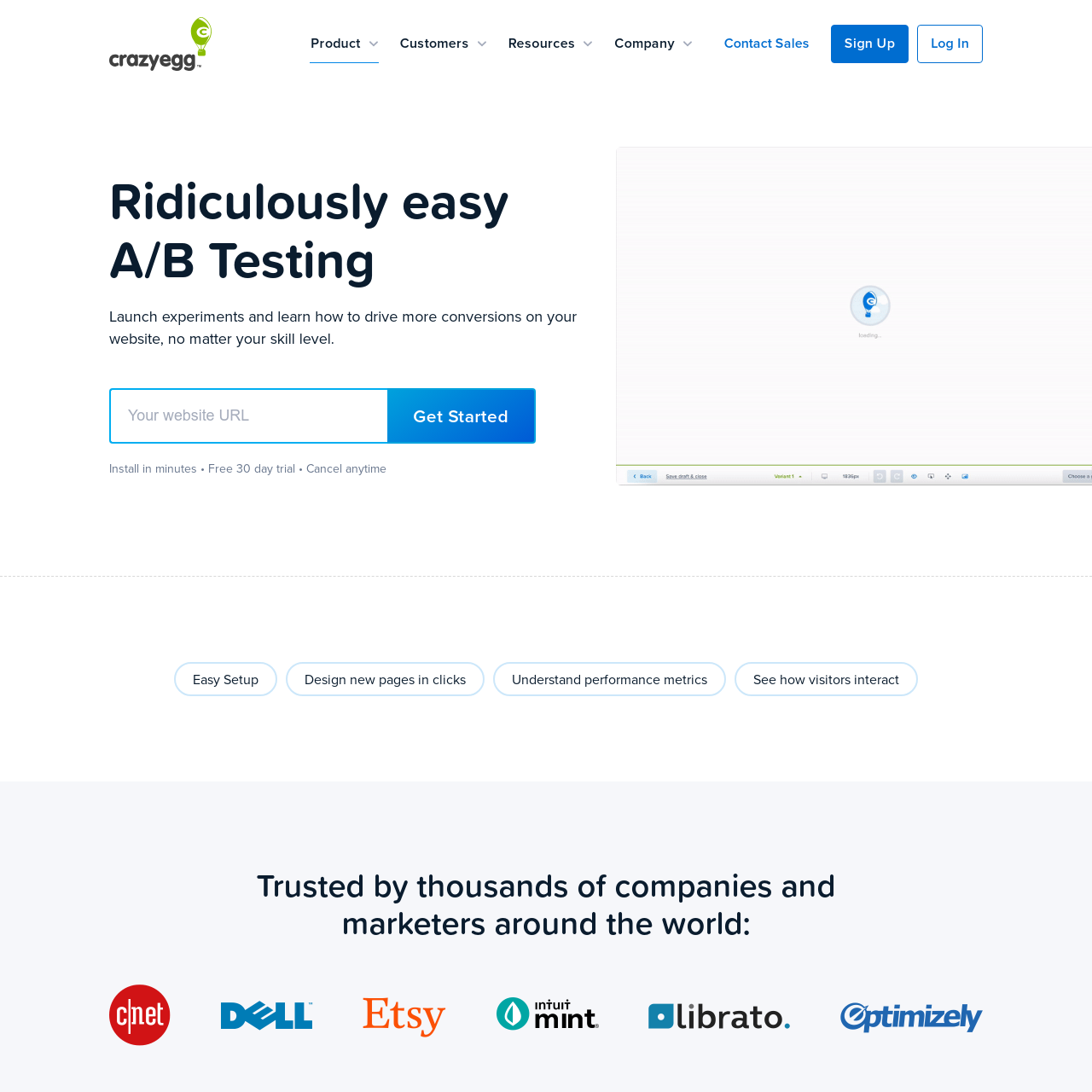
Crazy Egg offers visual analytics featuring heatmaps, scroll maps, and A/B testing to help businesses understand user behavior and improve website performance.
Key Features
- Easy Installation: Start collecting traffic data by adding Crazy Egg code snippets, using Google Tag Manager, or integrating with WordPress, Wix, Squarespace, Shopify, and more.
- Covers All Conversion Goals: Identify experiment goals quickly through clicks on buttons, landing on confirmation pages, form submissions, triggering advertising pixel events, or using a custom Crazy Egg event code snippet.
- Split Page Traffic Automatically: Utilize manual settings or our Multi-Arm Bandit Method to allocate visitors to the most effective page designs automatically.
- Visual Editor for New Testing Page Design: Use our Visual Page Editor to design new pages for testing or set up a traditional URL redirect to send traffic to an existing page.
- Track Conversions Visually: Offers a simplified view of conversion trends over time, allowing users to analyze conversion rates and statistical significance for various page designs.
- Heatmaps and Session Recordings: Utilize automatically generated Website Heatmaps and Session Recordings for each page design to identify user engagement and address conversion barriers.
- Track More Insights in Google Analytics: Crazy Egg’s easy integration sends pageview and conversion data to your Google Analytics 4 account, providing detailed engagement metrics and dimensions for A/B tests and page variants.
Business Pain Points
- Businesses don’t understand user behavior beyond standard A/B testing.
- No visual data insights are available for optimization.
How Crazy Egg’s A/B Testing Works?
- Crazy Egg offers heatmaps, scroll maps, and session recordings to analyze user interactions.
- Combines A/B testing with visual behavior tracking for better UX improvements.
Who uses it?
Etsy, CNET, and Dell use Crazy Egg for user behavior analysis.
Limitation
- Limited advanced testing features compared to enterprise tools
- Basic analytics may not be sufficient for larger businesses
Pricing Structure
The Starter plan starts at $29 per month, Plus plan at $99 per month, Pro plan at $249 per month and Enterprise plan at 499 per month with a 30-day free trial on all plans.
Honorable Mentions – More A/B Testing Tools
10. Split.io
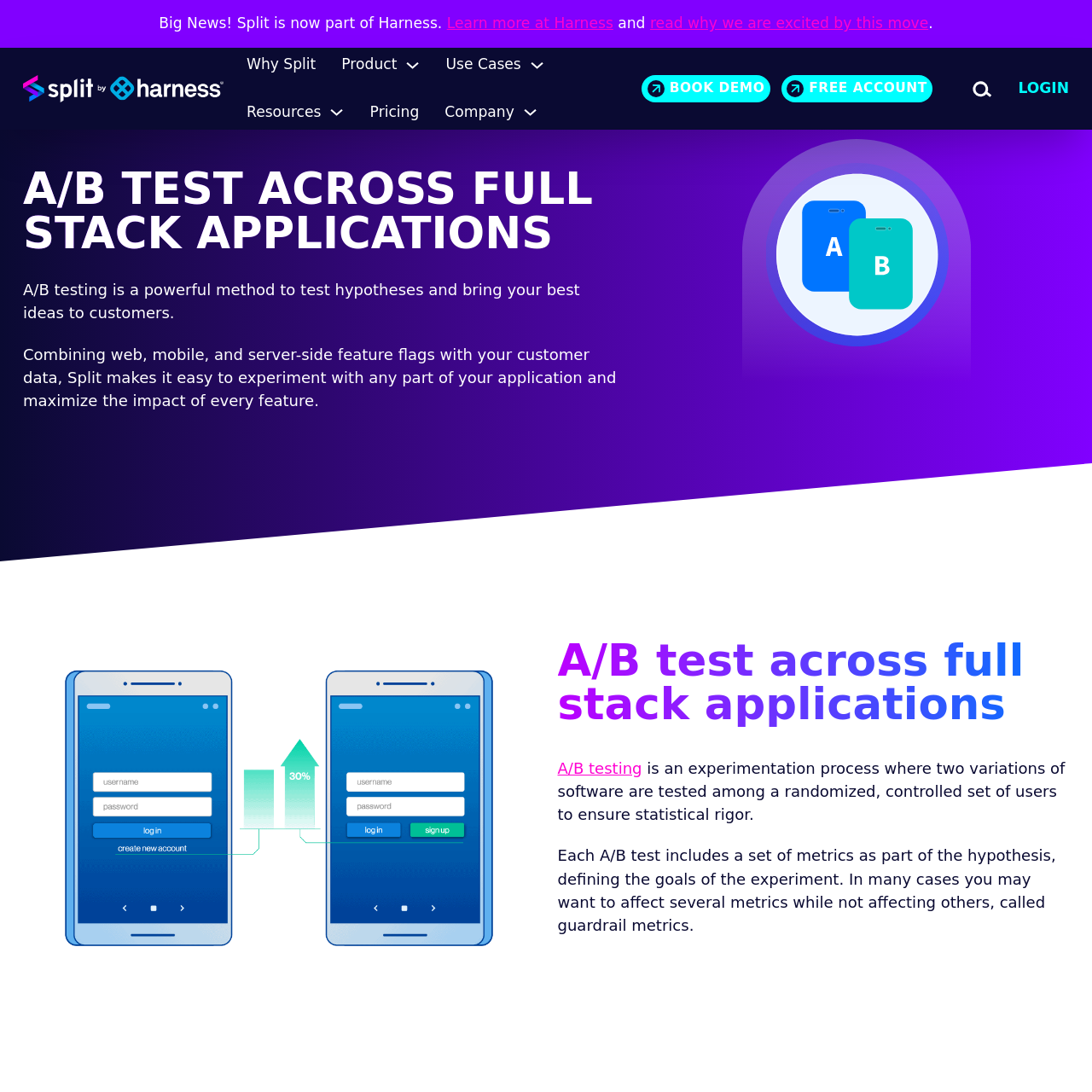
Split.io is a powerful feature flagging and experimentation tool designed for engineering teams to test, release, and roll out features with confidence with minimal risk.
Business Pain Point
Engineering teams need a feature flagging system with robust A/B testing capabilities.
How Split.io’s A/B Testing Works?
Split.io combines feature flags with A/B testing, allowing developers to release and test features gradually without affecting all users.
Who uses it?
Companies with agile development teams, including SAP and QANTAS.
11. Dynamic Yield
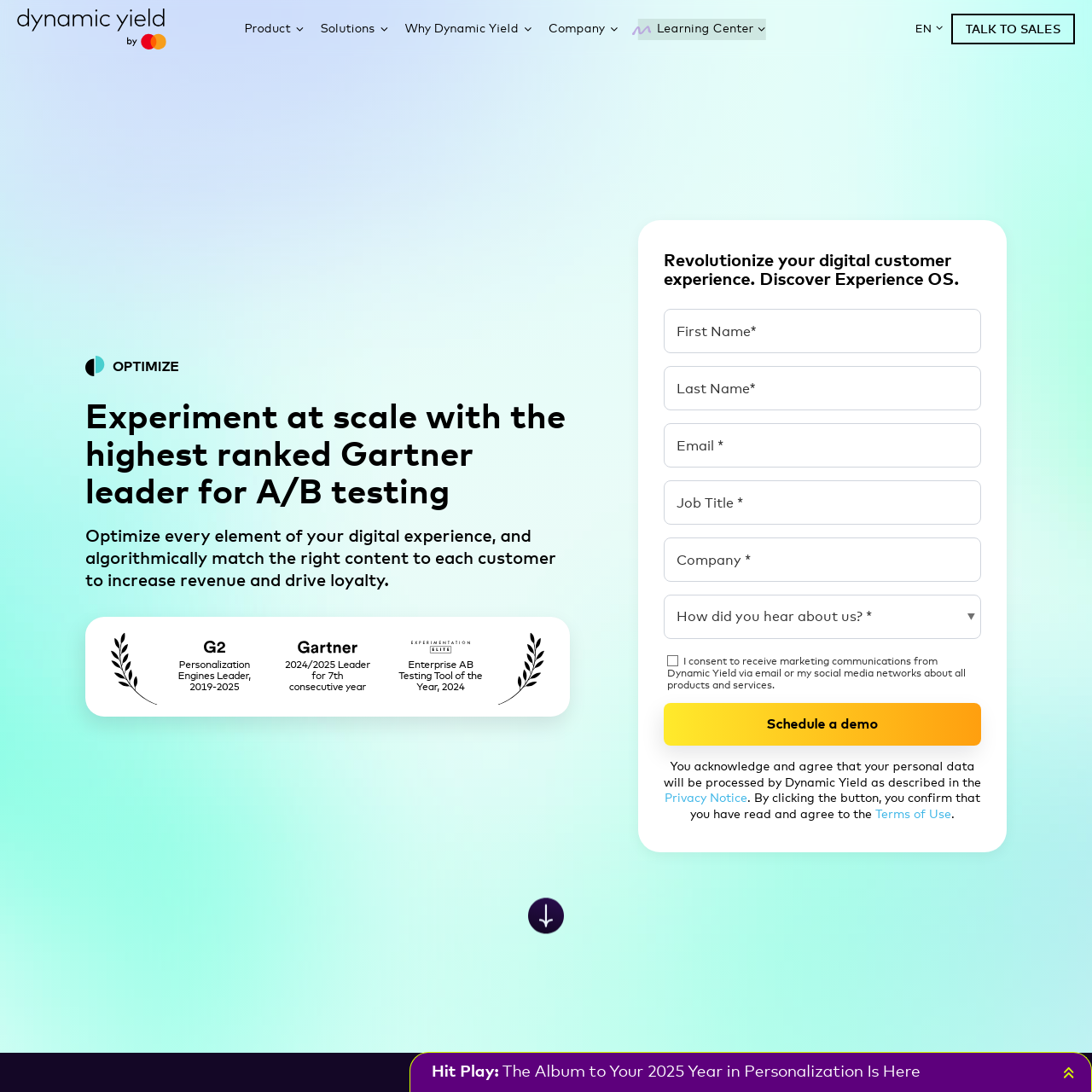
An AI-driven personalization and A/B testing too, Dynamic Yield helps businesses deliver tailored customer experiences through predictive targeting and real-time optimization.
Business Pain Point
E-commerce and media companies need AI-driven personalization alongside A/B testing.
How Dynamic Yield’s A/B Testing Works?
Dynamic Yield enables personalized recommendations, dynamic content testing, and customer segmentation to improve conversion rates.
Who uses it?
McDonald’s, L’Oréal, and PACSUN trust Dynamic Yield for personalization.
Pricing
You need to contact their sales team for getting the quote.
12. Statsig
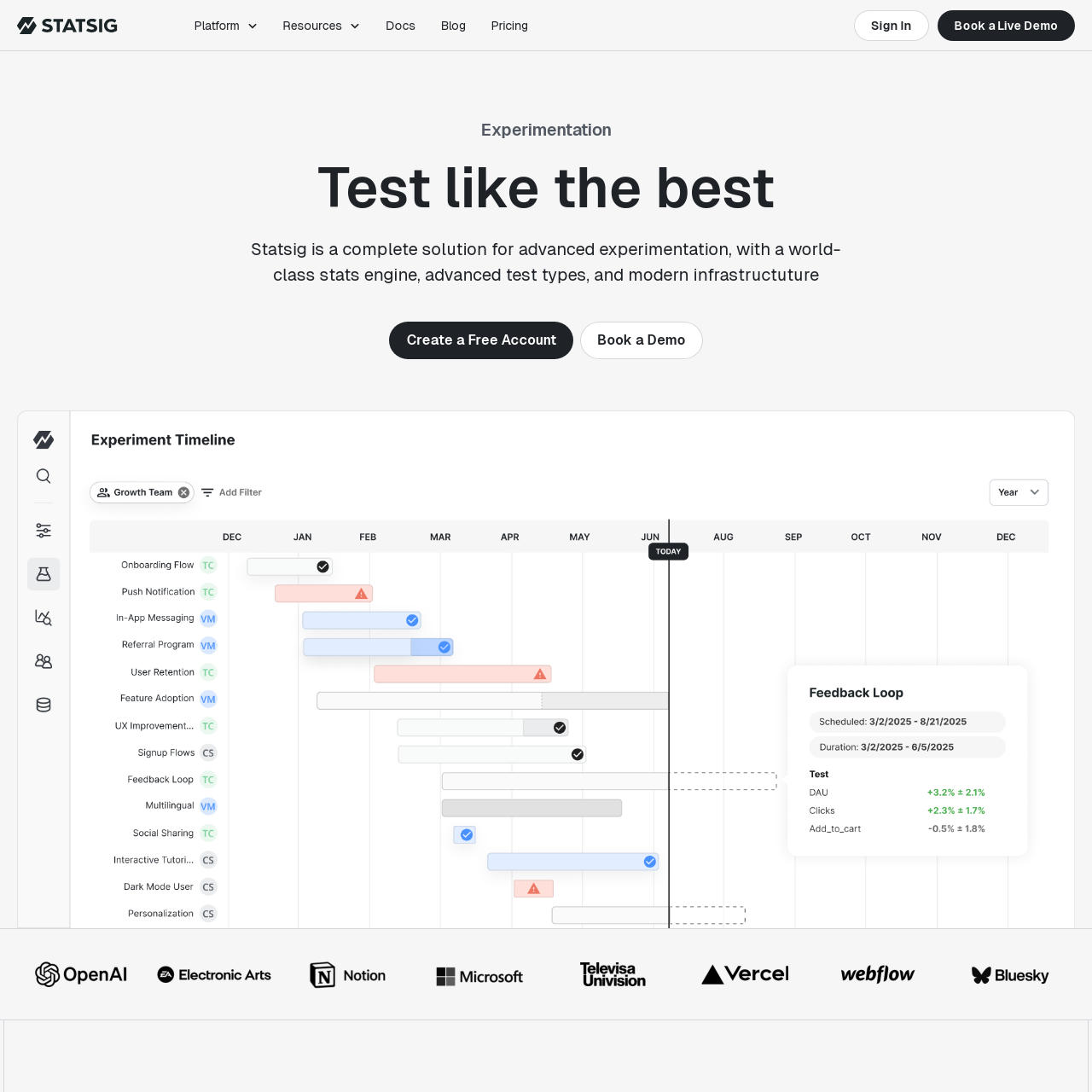
Statsig is a feature management and experimentation tool empowering product and engineering teams to run large-scale A/B tests, analyze impact, and roll out features with data-driven confidence.
Business Pain Point
Product and engineering teams need a robust experimentation platform that integrates with feature management and analytics.
How Statsig’s A/B Testing Works?
- Statsig allows teams to test new features, analyze their impact, and gradually roll out updates with automated statistical analysis.
- The platform is built for high-scale testing and integrates with data warehouses for deeper insights.
Who uses it?
Notion, Bluesky and SOUNDCLOUD are some of the popular users of Statsig.
Pricing
The platform offers a Developer plan for free, followed by a Pro plan starting at $150/month. The Enterprise plan pricing depends on the business needs.
13. Eppo
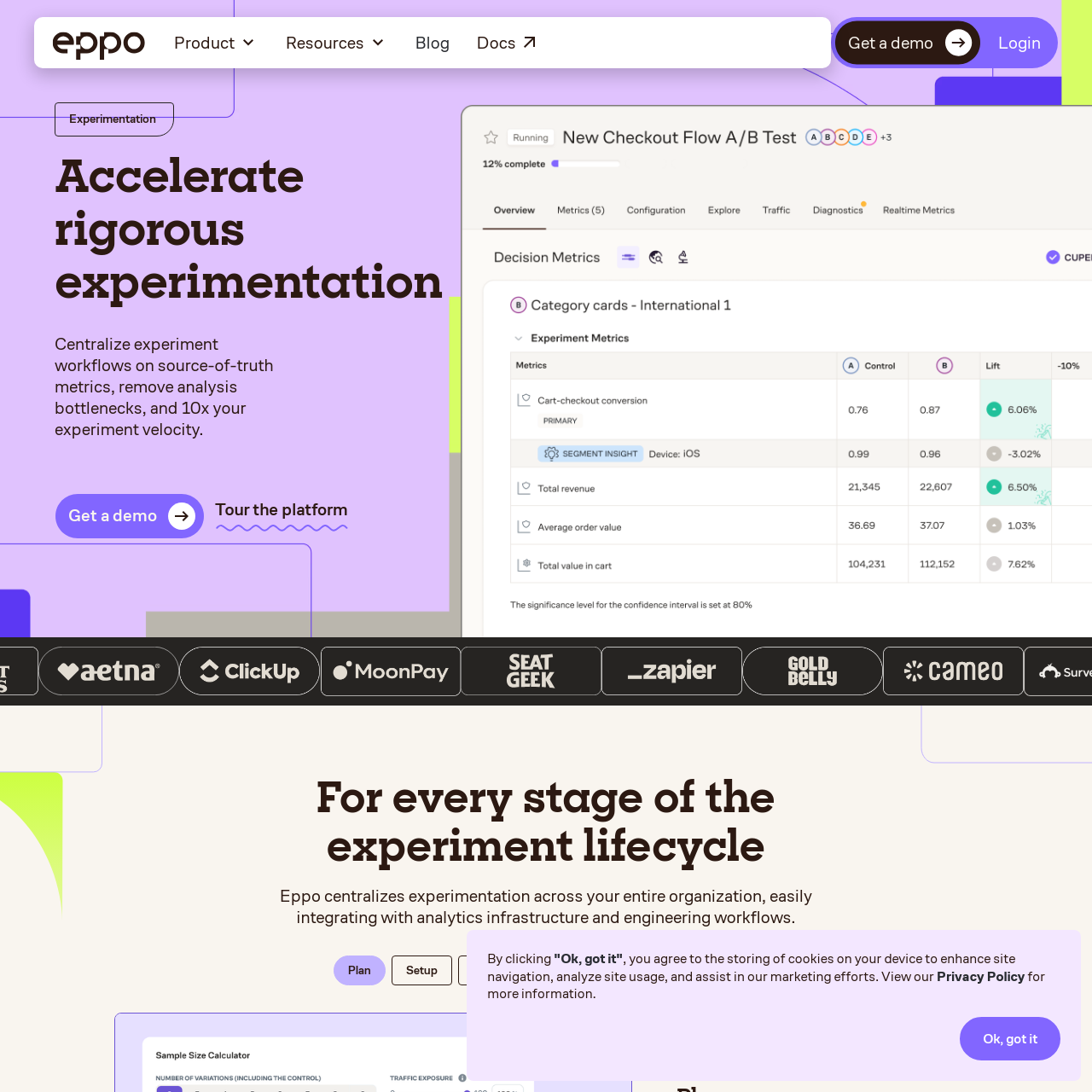
Eppo is a data-first experimentation platform designed for modern analytics teams, integrating seamlessly with data warehouses to run statistically rigorous A/B tests.
Business Pain Point
Data-driven companies need an experimentation platform that integrates seamlessly with modern data infrastructure.
How Eppo’s A/B Testing Works?
- Eppo is designed for data-first organizations and integrates with Snowflake, BigQuery, and Redshift to analyze A/B test results directly within data warehouses.
- It supports multi-metric analysis, longitudinal tracking, and statistical modeling, making it ideal for complex experimentation needs.
Who uses it?
ClickUP, SurveyMonkey and Miro use it for advanced data processing.
Pricing
For detailed pricing, you need to reach out to Eppo’s sales department.
14. AB Smartly
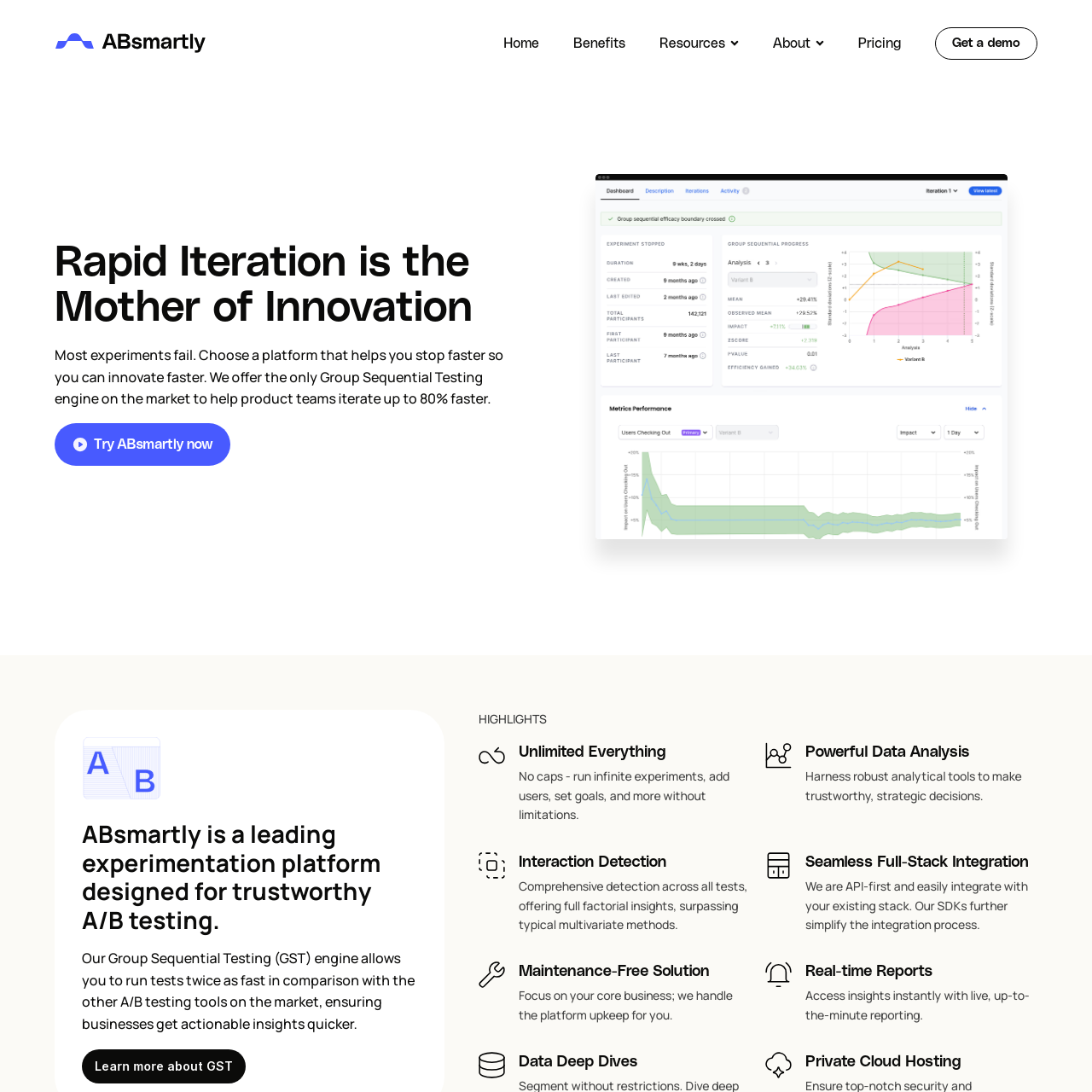
AB Smartly’s high-speed, full-stack experimentation offers real-time insights and flicker-free testing, enabling enterprises to optimize customer experiences efficiently.
Business Pain Point
Enterprises need high-speed experimentation with real-time insights while maintaining data accuracy.
How AB Smartly’s A/B Testing Works?
- AB Smartly provides a full-stack experimentation platform that enables companies to run large-scale A/B tests across multiple touchpoints.
- It features real-time data streaming, flicker-free testing, and statistical rigor, ensuring businesses get precise results without slowing down performance.
Who uses it?
Companies with a strong focus on data-driven decision-making, including large-scale enterprises and fast-growing digital businesses.
Pricing
AB Smartly offers all features for everyone at €60K / year starting at 50 Million events per month.
What are the Criteria for Selecting an A/B Testing Tool?
Selecting the best A/B testing tools helps businesses get the insights they need to improve their website’s engagement and convert visitors into potential customers.
- Types of Testing the Tool Offers
Different types of tests help to improve a website’s performance and engagement. Check whether the A/B testing tool offers split, multivariate, or server-side testing features.
- Ease of Use
Though the testing tool is powerful and will offer you all the required insights, it would be useless if it is complicated. When selecting an A/B testing tool, ensure it is easy to use and fit for your team size.
- Check for Integrations
You need to assess if the tool integrates with your website, CRM, and analytics tools. Select a tool that offers seamless integration to smoothen the data management process.
- Review the Tool
User reviews will help you select the right tool by identifying each user’s experience. Check what the product managers and marketers speak about the tool. Compare A/B testing features and pricing of the tool selected with other tools to learn about the strengths and weaknesses for making the right decision.
- Data Collection and Analysis
Ensure the tool offers complete data to learn about your progress towards your target. Also, the tool should provide insightful analysis for updating your strategy.
- Target Audience
All your website visitors are different. The tool should offer enhanced targeting and segmentation features to target the audience based on behavior, demographics, requirements, and other attributes.
- Customer Support
Check if the tool offers customer support via chat, email, or phone support. Also, the tool should have documentation and tutorials related to common user queries.
- Pricing
When selecting the A/B testing tool, consider the pricing structure. Check for additional fees for add-on features or high traffic. Ensure there is no hidden cost, and choose the tool that meets your requirements along with ease of use.
How to Implement A/B Testing Tools Effectively?
A/B testing enables organizations to improve website performance by comparing different page versions. Following a structured strategy leads to more accurate outcomes and enhanced decision-making.
Steps to Set-up A/B Test
- Set Your Goal: Determine what you want to enhance, such as conversion rates, signups, or engagement.
- Select the Element to Test: Concentrate on a single adjustment, such a headline, call-to-action button, page layout, or image.
- Opt for the Right Tool: Use an A/B testing platform that meets your technical requirements and works seamlessly with your analytics program.
- Set up the Variants: Make a modified version of the original page, leaving all other parts unchanged.
- Launch the Test: Deploy the test and confirm it runs without technical difficulties. Monitor traffic distribution to ensure an equal split between variations.
- Analyze the Results: Analyze the collected data to determine which version performed best. Analyze analytics like conversion rates, bounce rates, and user engagement.
- Implement the Best Variant: If the test reveals a significant improvement, use the successful version permanently. Continue to try different elements to improve performance.
Best Practices for Running Successful Experiments
- Test One Change at a Time: Changing numerous elements at once makes it difficult to determine what caused the difference in performance.
- Let the Test Run Long Enough: Ending a test too soon can lead to false results. Wait until there are enough visitors to get a reliable result.
- Segment Your Audience: Analyzing data by user type, device, or location can yield additional relevant information.
- Use Statistical Significance: A result is meaningless unless there is a high degree of certainty that the modification has an impact.
- Track External Factors: Holidays, promotions, and abrupt traffic spikes can all impact outcomes, so keep this in mind while reviewing statistics.
Conclusion
Implementing A/B testing into your website optimization strategy is essential for making informed, data-driven decisions that enhance user experience and drive conversions. The nine tools we’ve explored—Optimizely, VWO, AB Tasty, Adobe Target, Kameleoon, Apptimize Inc., Omniconvert S.R.L., Convert.com, and Crazy Egg—each offer unique features tailored to various business needs.
By carefully assessing the above factors, you can select an A/B testing tool that fits your current needs and supports your long-term optimization goals. Remember, the key to successful A/B testing is continuous experimentation and adaptation, ensuring your website evolves according to user preferences and market trends.
